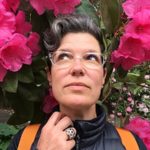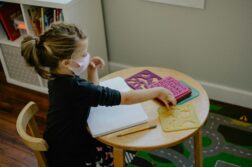
I wanted a puppy. My wife did not. It took almost a year of gentle negotiation, but I eventually convinced Jenn with the following argument: Dogs make everything better.
So we picked a golden retriever puppy from a breeder’s litter and named her Edie. We chose Edie because we like vintage names, but in hindsight we realized there are many kickass women who could’ve been her namesake: Piaf, Head, Bunker, Brickell, Bouvier, Wharton. Loveable oddballs, all of them.
Jenn’s main reservation was that she wouldn’t be able to carve out enough time to raise Edie with the demands of working as a San Francisco police lieutenant. But as the stay-at-home writer, I assured her I would have plenty of time to train and exercise our new puppy. I’d raised two goldens already, I pointed out.
Once Edie had learned to walk on a leash in puppy class, I took her for a morning outing to Fort Funston in San Francisco. If dogs had a Disneyland, this would be it. A decommissioned military bunker on the windswept sandstone cliffs overlooking the Pacific, it’s now a national park, where hundreds of dogs romp off-leash over dunes, through the waves, and along forested trails that are outfitted with dog water stations. My other two goldens had lived for it. Fort Funston is routinely voted San Francisco’s best dog hangout in a city so canine-crazy that dogs outnumber children.
Not that there’s anything wrong with that. That’s just how we roll in our 7×7-square mile city, pushing our pampered pups in strollers to daycare or water aerobics or acupuncture treatments. San Francisco is loaded with dual-income, childless-by-choice, gay and lesbian couples who strengthen their relationships by co-parenting dogs in this most unnatural of animal habitats. Getting a puppy, I thought, would be the next step in our relationship. Caring for a creature together would fuse Jenn and me into a family.
On our first Fort Funston walk, Edie took interest in a bulldog puppy, and I unclipped her leash so she could play with him. The spectacle of their instant love affair stopped foot traffic, and I remember basking in the glow of all the adoration when suddenly, gunshots rang out from the nearby police shooting range. Edie vanished in a blond blur, claws digging the earth for speed, heading straight for the sea cliff.
I ran screaming after her, but my pace was nightmarishly slow as I watched Edie get smaller and smaller, and the cliff get closer and closer. She banked left just before the drop-off, but then careened toward the busy parking lot. Edie miraculously skirted traffic and tore over a sand dune netted with ice plant until finally two hikers were able to capture her.
That was the moment I realized something was wrong with our perfect puppy. Edie’s fight-or-flight was off the charts. As the weeks went by, we saw that it wasn’t just gunshots that scared her, it was everything about living in a busy, overstimulating urban city. Every time we took her outside, something sent her into a panic.
One day it was an umbrella. Or the whir of a helicopter. A fire hydrant. A barking dog. A garage door opening. Dandelion fluff on the wind. Each time we opened the front door our dog smelled danger and refused to leave the house. I had never encountered a dog so fragile. Edie had debilitating city-phobia. As a result, we became trapped indoors with our agoraphobic dog, and our membership in San Francisco’s thriving dog culture was effectively canceled – for the next ten or twelve years.
This was not the puppy fun I’d promised my wife.
The trainers, vets, and behaviorists we consulted had many names for the kind of dog Edie is: hyper-vigilant, sensitive, neuro-diverse, anxious, reactive, special needs. We tried swaddling vests, CBD treats, soothing music designed for dogs, socialization classes, a sound desensitization app, confidence training exercises, noise-cancelling headphones, Prozac and Xanax. We even hired a pet psychic.
“How do we fix this?” we kept asking.
Turns out we were asking the wrong question. As Edie’s anxiety grew more extreme, I kept looking for ways to change her, to somehow turn her back into the dog I felt we’d been cheated out of. But all Edie was doing was asking us to see her for who she is. Different, not defective.
It took us a year to finally let go of our expectations and our egos, as Edie patiently taught us that pets are not here for our amusement, or to serve as our accessories, but to teach a lesson we need to learn. Edie taught me that sometimes the point of a dog is to teach you how to put yourself second. And in doing so, Jenn and I both found a maternal instinct neither of us thought we had.
Loving Edie means giving up some freedoms. We can’t simply go anywhere with our dog in tow. Edie needs multiple, short introductions to a new environment before she acclimates and can feel safe there. We also need backup plans, and her emergency toolkit loaded with medications and calming pheromone sprays in case she gets frightened. We can’t push her to do what we want her to do, rather we have learned to read her body language and pull her out of a situation before she escalates. And then to not put judgment on it.
Instead of focusing on all Edie can’t do, we applaud Edie for doing the best she could that day. My wife said it best: “Edie can only handle the world in little bits.”
Managing Edie’s stress tested the limits of our compassion and our strength as a couple, but the shared struggle has bonded us closer than had we been given an easy dog. Edie made us face our disappointment and reframe what it means to share a life with another being. Edie’s timidity will require lifelong accommodations, but I can’t imagine anyone else giving them to her but us.
Now, when Edie panics, she runs to me. I feel a rush of love and purpose as her chosen protector. She may never be the dog I had in mind, but that’s just the point, she’s her own creature with her own quirks. She needs me, and that’s all that matters. She has taught me that love is better when it comes without conditions. We’ve learned to love our loveable oddball because of, not in spite of, her limitations.
Which begs the question … Who’s training who?
 Meredith May is the author of THE HONEY BUS: A Memoir of Loss, Courage and a Girl Saved by Bees, which was published in 18 countries. Her new memoir, LOVING EDIE: How A Dog Afraid Of Everything Taught Me To Be Brave, will be published April 19 and can be purchased here. She was previously an award-winning journalist for the San Francisco Chronicle. She is a fifth-generation beekeeper, and lives in Carmel Valley with her wife, Jenn, and their golden retriever, Edie.
Meredith May is the author of THE HONEY BUS: A Memoir of Loss, Courage and a Girl Saved by Bees, which was published in 18 countries. Her new memoir, LOVING EDIE: How A Dog Afraid Of Everything Taught Me To Be Brave, will be published April 19 and can be purchased here. She was previously an award-winning journalist for the San Francisco Chronicle. She is a fifth-generation beekeeper, and lives in Carmel Valley with her wife, Jenn, and their golden retriever, Edie.






